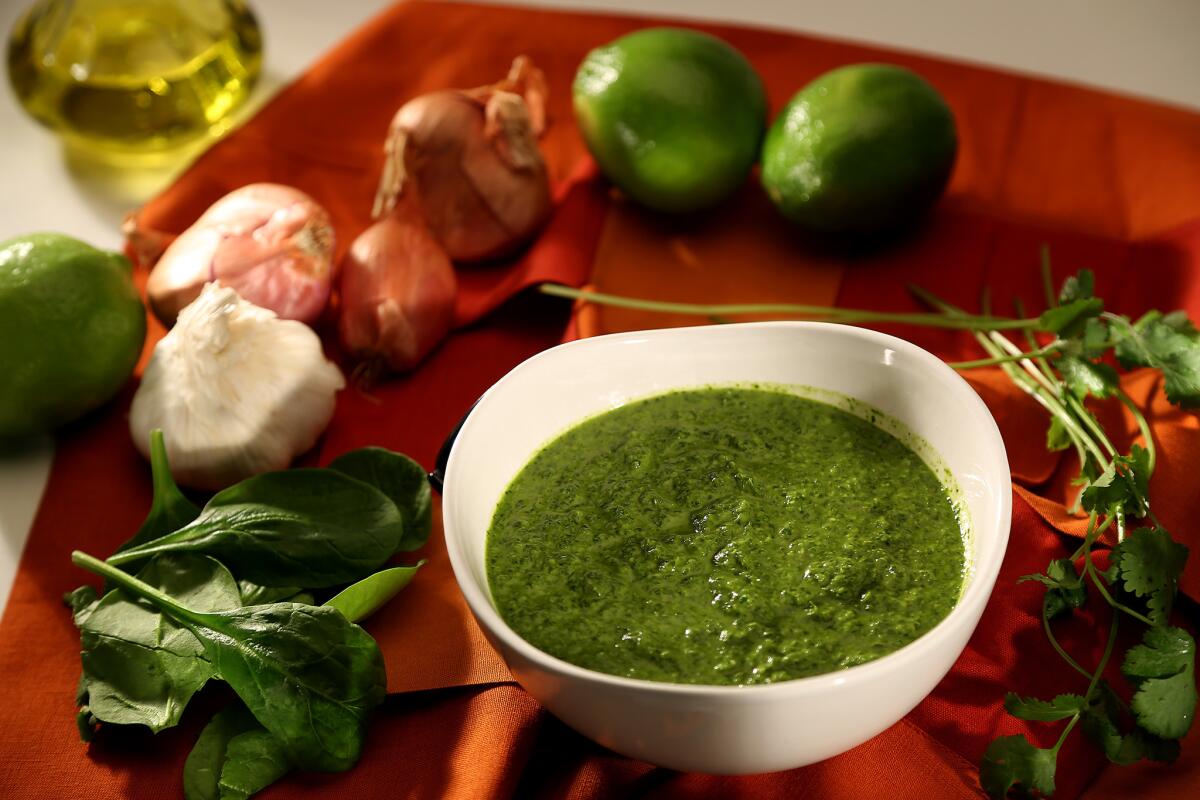Salsa verde is green with possibilities as a sauce, dip or flavoring

- Share via
Of the myriad dishes that sound better in languages other than English — tonkotsu for pig broth, xiaolongbao for soup dumplings — you might want to add salsa verde. Because green sauce, although plain and serviceable, sounds about as appetizing as a bowl of your kid’s kindergarten paint.
Call it what you like, salsa verde can be one of the most versatile and lovely sauces in any cook’s repertoire.
It’s easy, as you just throw a bunch of green stuff in a food processor (or a blender, or a mortar and pestle). It’s seasonally adjustable; the green stuff can be whatever you find at the farmers market — or languishing in your refrigerator. And you can tailor it to what you feel like cooking.
Historically, salsa verde has been many things to many people. In general, it’s defined as a sauce of herbs, some sort of acid (vinegar, citrus), olive oil (or mayonnaise) and perhaps dairy. You can add anchovies and capers or make it with or without tomatillos, garlic, onions and, of course, chiles. In the Middle East or Africa, you might throw cardamom, caraway and chiles in with your parsley and cilantro and call it zhoug. In Germany, you might add eggs and serve the stuff with schnitzel. Goethe apparently put it on everything, or at least his mother said he did.
If parsley or cilantro is your baseline, add or substitute a handful of mint or basil or chervil. Instead of spinach, use a bunch of arugula or even raw kale. (Just make sure that the greens you use are fresh and tender and that you’ve pulled off any thick stems.) Maybe (please) think of it as an alternative to juicing.
You can also get more creative and throw some fresh kaffir lime leaves into the blender or experiment with the spectrum of your favorite chiles (if not a slice of jalapeño, then a few serranos or Fresno chiles). When you add citrus (use a splash of cider vinegar if you’re bereft of fresh lemons or limes), the zest adds another level of flavor that you can move up or down depending on your fondness for, well, flavor.
And then there are all the spices in your cabinet that can torque up the sauce even further. Throw in some ground Sichuan peppercorns, or add some minced fresh ginger.
As for what exactly to do with a Mason jar of this stuff when you’re done, think of it as a dipping sauce, a condiment — a salad in a cup. Not unlike gremolata or pistou, it’s good spooned onto grilled meat, fish and chicken, or into soups. Stir plenty of it into a big bowl of brown rice or a somewhat smaller bowl of ricotta. Dip your bread into it, or use it as a sauce for tacos or savory crepes. Since it’s spun herbs and spinach, you can use it for an easy dose of greenery if you’re too busy (really?) to make an actual salad.
Just keep your new jar of salsa verde in the refrigerator and not in your car — as many of us do with hot sauce — since its charm, and much of its flavor, is contingent upon freshness. It’s green, after all, for a reason.
More to Read
Eat your way across L.A.
Get our weekly Tasting Notes newsletter for reviews, news and more.
You may occasionally receive promotional content from the Los Angeles Times.











